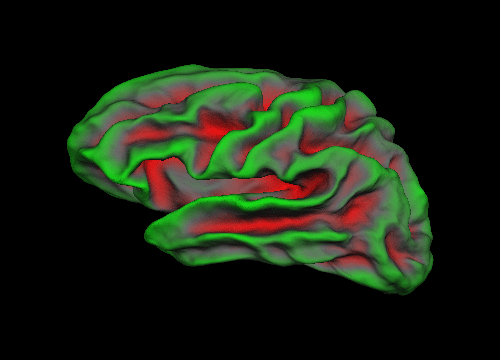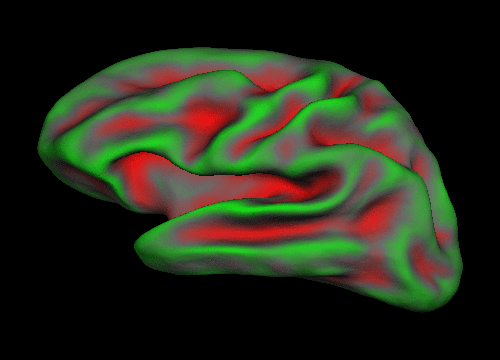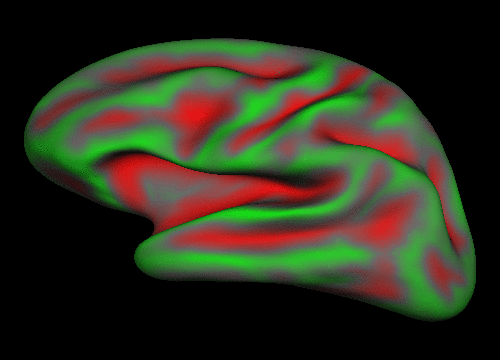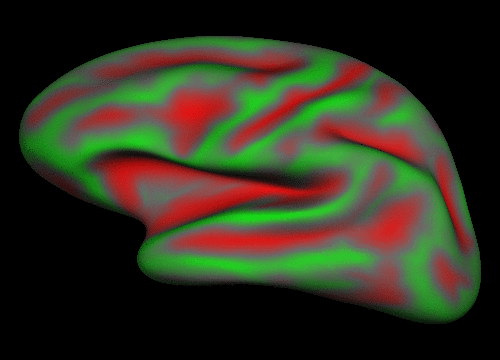Exploring Filters on Spherical Surfaces & Understanding Geometry of the Brain
Boon Thye T. Yeo & Polina Golland
Motivation and Goal
We are interested in extending image processing techniques (in particular steerable filters) to spherical surfaces. Spherical filtering has numerous applications in diverse fields, including surface modeling, texture processing[1, 2] and cosmic microwave background (CMB) analysis[3]. Our particular motivation comes from the representation of cortical surfaces as functions on spheres. Neurobiologists believe that most of our higher cognitive abilities originate from the cerebral cortex, and that neurological growth or diseases significantly alter the structure of the cortex. Our long term goal is therefore to find useful representations or features of cortical surfaces that allows us to track changes and development of the brain (and indirectly cognitive capabilities). Currently, we are working with cortical surfaces that are mapped onto the topologically-equivalent spherical surfaces (see collaborators), and is done in a 3-stage process of segmenting the cortical surfaces from 3D MRI images, inflating the segmented surfaces and then projecting the surfaces onto the sphere (see figure below).
 |
 |
 |
 |
These figures
show the sequential inflation of the segmented cortical surfaces.
Courtesy of Bruce Fischl, MGH. |
|||
Background
Oriented filters are important in many computer vision tasks. Oftentime, objects of interest in images have distinct edges that can be detected by oriented filters. Furthermore, it has been shown that the human primary visual cortex has an entire network of complex neurons that respond to gradients at particular orientation and spatial frequency. Therefore oriented filters can function as analogous mechanisms for detecting features in many scene understanding, tracking and object recognition tasks.
In the case of cortical brain surfaces, neurobiologists currently characterize the undulating brain surface by the distinctive pattern of major sulci and gyri. These sulci and gyri could conceivably be traced and measured by oriented filters defined on spherical surfaces. Extending the class of 2D oriented filters to the spherical surface will therefore give us a new set of tools to explore and understand the geometry of the brain and its relations to cognitive functionalities.
One problem that often arises in using directed filters is the need to calculate its response at many arbitrary orientations. An inefficient approach might be to apply all the different oriented versions of the same filter. With a steerable filter however, one can simply apply the filter at a few orientations and perform a perfect interpolation for intermediate orientations. This is because a steerable filter is by definition expressible as linear sum of rotated versions of itself. Conditions for steerable filters were first formulated by Freeman and Adelson[4] applicable to 2D and 3D euclidean spaces. Multiscale image analysis using steerable pyramids has since then become a useful tool for image analysis[5].
A recent formulation by Wiaux et al[3] defines steerable filters on spherical surfaces via a stereographic mapping between 2D euclidean plane and the spherical surface. Through this stereographic projection, Wiaux et al went on to define steerable spherical wavelets.
Approach
We are currently working on implementing and evaluating Wiaux's approach. Wiaux's approach is attractive because it provides a method of designing interesting filters on the 2D plane and transforming it onto the spherical surface. Unfortunately, the entire derivation was done theoretically in the continuous domain, and so there might be unforseen discretization effects. Since the stereographic projection is almost homogeneous near the north pole, discretization errors should be negligible for filters of small local support relative to the discretization of the spherical surface. However, for multiscale image analysis, the filters' support may grow much larger as the scale increases. Furthermore, it would be illuminating to compare Wiaux's formulation of spherical wavelets with Wim Swelden's more general lifting technique[6] that applies to arbitrary metric spaces in Rn.
Collaborators
Florent Segonne (MIT), Peng Yu (MIT), Bruce Fischl (MGH), Ellen Grant (MGH), Andrea Mewes (BWH), Simon Warfield (BWH)
Acknowledgement
This work is made possible as a result of the NIH NINDS 1-R01-NS051826-01 grant and support from the Agency of Science, Technology and Research.
References:
[1] Peter Schroder and Wim Sweldens. Spherical Wavelets: Efficiently Representing Functions on the Sphere. In Computer Graphics Proceedings (SIGGRAPH 95), pp. 161-172, 1995.
[2] Peter Schroder and Wim Sweldens. Spherical Wavelets: Texture Processing In Rendering Techniques '95 pp. 252-263, Aug, 1995.
[3] Y. Wiaux, L. Jacques and P. Vandergheynst. Corresponding Principle Between Spherical and Euclidean Wavelets. Submitted. Astrophysics, 2005.
[4] William T. Freeman and Edward H. Adelson. The Design and Use of Steerable Filters. In IEEE Transactions on Pattern Analysis and Machine Intelligence, Vol 13, No. 9, pp. 891-906, Sep 1991.
[5] Eero P. Simoncelli, William T. Freeman, Edward H. Adelson, David J. Heeger. Shiftable Multiscale Transforms. In IEEE Transactions on Information Theory Vol 38(2), pp. 587-607, Mar 1992.
[6] Wim Sweldens. The Lifting Scheme: A Construction of Second Generation Wavelets. In Siam Journal of Mathematical Analysis Vol 29, No. 2, pp. 551-546, Mar 1998.
The Stata Center, Building 32 - 32 Vassar Street - Cambridge, MA 02139 - USA tel:+1-617-253-0073 - publications@csail.mit.edu (Note: On July 1, 2003, the AI Lab and LCS merged to form CSAIL.) |
